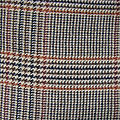Tweed
Tweed is a rough, woollen fabric, of a soft, open, flexible texture, resembling cheviot or homespun, but more closely woven. It is usually woven with a plain weave, twill or herringbone structure. Colour effects in the yarn may be obtained by mixing dyed wool before it is spun.[1]
Tweeds are an icon of traditional Scottish, Irish, Welsh, and English clothing, being desirable for informal outerwear,
Etymology

The original name of the cloth was tweel, Scots for twill, the material being woven in a twilled rather than a plain pattern. A traditional story has the name coming about almost by chance. Around 1831, a London merchant, James Locke, received a letter from a Hawick firm, Wm. Watson & Sons, Dangerfield Mills about some "tweels". The merchant misinterpreted the handwriting, understanding it to be a trade-name taken from the River Tweed that flows through the Scottish Borders textile area. The goods were subsequently advertised as Tweed and the name has remained since.[5]
Traditions and culture

Traditionally used for upper-class country clothing such as
During the 2000s and 2010s, members of long-established British and American land-owning families started to wear high-quality heirloom tweed inherited from their grandparents, some of which pre-dated the Second World War.[11][12]
In modern times, cyclists may wear tweed when they ride vintage bicycles on a
Musical instruments
Some vintage
The term "tweed" is used to describe coverings on instrument cables and vintage or
Types of tweed
This section needs additional citations for verification. (October 2021) |
- Harris Tweed: A handwoven tweed, defined in the Harris Tweed Act 1993 as cloth that is "Handwoven by the islanders at their homes in the Outer Hebrides, finished in the Outer Hebrides, and made from pure virgin wool dyed and spun in the Outer Hebrides".[16]
- gorse (whins), and moss.
- Silk tweed: A fabric made of raw silkwith flecks of colour typical of woollen tweed.
- Saxony tweed: Originated in Saxony, Germany. It is a fabric made from the wool of merino sheep. It is very smooth and soft.
Gallery
-
Logo of theHarris Tweedauthority
-
Glen plaid, Glenurquhart, or Prince of Wales check, frequently used to make overcoats and sportcoats in the 1950s
-
Example of thesuitsand outerwear
-
Houndstooth, the basis of the keeper's tweed popular among the upper classes from the 1860s until the 1930s
-
Greysportcoat
-
Agamekeeper's tweed (contrasting mustard, green and brown checks)
-
Windowpane tweed popular in the late 19th century and again in the 1970s
-
Wilhelm wearing highland dress including tweed kiltjacket
-
Hunting apparel belonging toGustaf V of Sweden, 1930s.
-
Harris Tweed Nike
-
Charlie Hunter (left) watches as Old Tom Morris plays a shot in 1863 at Prestwick. Both of the players are wearing the traditional tweeds.
See also
- 1920s in fashion
- 1950s fashion
- 1960s fashion
- 1970s fashion
- 2000s in fashion
- 2010s in fashion
- British Country Clothing
- Norfolk jacket
- Sports Jacket
- Woollen industry in Wales
Notes
- ^ "Harris Tweed - The Cloth". The Harris Tweed Authority. Archived from the original on 15 August 2015. Retrieved 1 August 2015.
- ^ Fashion Institute of Technology (2006). ""The Tailor's Art" | Menswear Fabrics - A Glossary". The Museum at FIT. Archived from the original on 2 June 2007. Retrieved 24 November 2008.
- ^ "Tweed Jackets | A Closely Woven Thing". Cad & the Dandy. 20 November 2015. Retrieved 19 March 2019.
- ISBN 9781788492010.
- ISBN 978-1326384067.
- ^ Edward Minister and Son (August 1872). "The Norfolk Jacket". Gazette of Fashion, and Cutting-room Companion. 27 (316). Simpkin, Marshall & Co: 31.
- ^ Dutton, Edward (22 August 2014). "How to wear a tweed suit in the 21st century". A Suit That Fits. Archived from the original on 28 March 2019. Retrieved 26 January 2016.
- ^ loopy_lucy14 (31 October 1997). "Mr. Toad's Wild Ride (1996)". IMDb. Retrieved 27 July 2011.
{{cite web}}: CS1 maint: numeric names: authors list (link) - ISBN 0-7134-2534-2.
- ^ "The RL Style Guide | Glossary | Herringbone". Ralph Lauren. Archived from the original on 19 September 2008. Retrieved 24 November 2008.
- ^ "Nigel Cabourn DB Tweed Jacket - Rare Classic Quality?". Grey Fox. 5 September 2012. Retrieved 17 October 2013.
- ^ Bath, Richard (25 July 2009). "Richard Bath: In defence of tweed". The Scotsman. JPIMedia Ltd. Retrieved 17 October 2013.
- ^ "#TheChapMag Vintage Garments". The Chap Magazine. 11 September 2012. Archived from the original on 25 October 2013. Retrieved 8 August 2013.
- ^ Price, Richard (16 March 2013). "Harris Tweed Bagpipe Covers". The Big Cloth and Me. Retrieved 8 August 2013.
- ^ Hunter, Dave (July 2012). "The Fender 5F4 Super Amp". Vintage Guitar. pp. 50–52.
- ^ "About Us - Guardians of the Orb". The Harris Tweed Authority. Archived from the original on 8 March 2013. Retrieved 1 August 2015.
References
- Corrigan, Vawn (2020). Irish Tweed: History, Tradition, Fashion. O'Brien Press. ISBN 9781788492010.
- "What is Tweed?". A Hume.
- Reynolds, Francis J., ed. (1921). . Collier's New Encyclopedia. New York: P. F. Collier & Son Company.
- National Library of Scotland: SCOTTISH SCREEN ARCHIVE (archive films relating to tweed manufacture in Scotland)
- Anderson, Fiona (2016). Tweed. London: Bloomsbury Academic Press. ISBN 978-1-84520-697-0.
External links
 Media related to Tweed at Wikimedia Commons
Media related to Tweed at Wikimedia Commons











